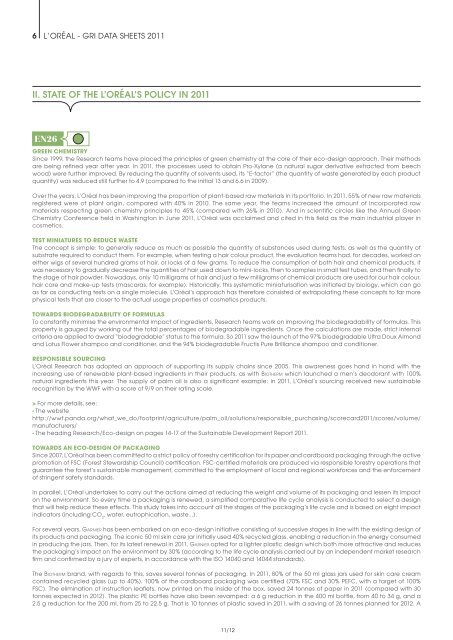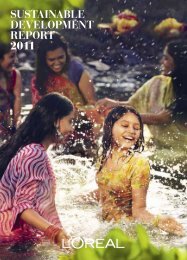Organizational Strategy - Sustainable Development - L'Oréal
Organizational Strategy - Sustainable Development - L'Oréal
Organizational Strategy - Sustainable Development - L'Oréal
Create successful ePaper yourself
Turn your PDF publications into a flip-book with our unique Google optimized e-Paper software.
6 L’oréaL - GrI DaTa SHEETS 2011<br />
II. STATE OF THE L’ORéAL’S POLICY IN 2011<br />
EN26<br />
GREEN CHEMISTRY<br />
Since 1999, the research teams have placed the principles of green chemistry at the core of their eco-design approach. Their methods<br />
are being refined year after year. In 2011, the processes used to obtain Pro-Xylane (a natural sugar derivative extracted from beech<br />
wood) were further improved. By reducing the quantity of solvents used, its “E-factor” (the quantity of waste generated by each product<br />
quantity) was reduced still further to 4.9 (compared to the initial 13 and 6.6 in 2009).<br />
over the years, L’oréal has been improving the proportion of plant-based raw materials in its portfolio. In 2011, 55% of new raw materials<br />
registered were of plant origin, compared with 40% in 2010. The same year, the teams increased the amount of incorporated raw<br />
materials respecting green chemistry principles to 45% (compared with 26% in 2010). and in scientific circles like the annual Green<br />
Chemistry Conference held in Washington in June 2011, L’oréal was acclaimed and cited in this field as the main industrial player in<br />
cosmetics.<br />
TEST MINIATURES TO REDUCE WASTE<br />
The concept is simple: to generally reduce as much as possible the quantity of substances used during tests, as well as the quantity of<br />
substrate required to conduct them. For example, when testing a hair colour product, the evaluation teams had, for decades, worked on<br />
either wigs of several hundred grams of hair, or locks of a few grams. To reduce the consumption of both hair and chemical products, it<br />
was necessary to gradually decrease the quantities of hair used down to mini-locks, then to samples in small test tubes, and then finally to<br />
the stage of hair powder. Nowadays, only 10 milligrams of hair and just a few milligrams of chemical products are used for our hair colour,<br />
hair care and make-up tests (mascaras, for example). Historically, this systematic miniaturisation was initiated by biology, which can go<br />
as far as conducting tests on a single molecule. L’oréal’s approach has therefore consisted of extrapolating these concepts to far more<br />
physical tests that are closer to the actual usage properties of cosmetics products.<br />
TOWARDS BIODEGRADABILITY OF FORMULAS<br />
To constantly minimise the environmental impact of ingredients, research teams work on improving the biodegradability of formulas. This<br />
property is gauged by working out the total percentages of biodegradable ingredients. once the calculations are made, strict internal<br />
criteria are applied to award “biodegradable” status to the formula. So 2011 saw the launch of the 97% biodegradable Ultra Doux almond<br />
and Lotus Flower shampoo and conditioner, and the 94% biodegradable Fructis Pure Brilliance shampoo and conditioner.<br />
RESPONSIBLE SOURCING<br />
L’oréal research has adopted an approach of supporting its supply chains since 2005. This awareness goes hand in hand with the<br />
increasing use of renewable plant-based ingredients in their products, as with Biotherm which launched a men’s deodorant with 100%<br />
natural ingredients this year. The supply of palm oil is also a significant example: in 2011, L’oréal’s sourcing received new sustainable<br />
recognition by the WWF with a score of 9/9 on their rating scale.<br />
> For more details, see:<br />
- The website<br />
http://wwf.panda.org/what_we_do/footprint/agriculture/palm_oil/solutions/responsible_purchasing/scorecard2011/scores/volume/<br />
manufacturers/<br />
- The heading research/Eco-design on pages 14-17 of the <strong>Sustainable</strong> <strong>Development</strong> report 2011.<br />
TOWARDS AN ECO-DESIGN OF PACKAGING<br />
Since 2007, L’oréal has been committed to a strict policy of forestry certification for its paper and cardboard packaging through the active<br />
promotion of FSC (Forest Stewardship Council) certification. FSC-certified materials are produced via responsible forestry operations that<br />
guarantee the forest’s sustainable management, committed to the employment of local and regional workforces and the enforcement<br />
of stringent safety standards.<br />
In parallel, L’oréal undertakes to carry out the actions aimed at reducing the weight and volume of its packaging and lessen its impact<br />
on the environment. So every time a packaging is renewed, a simplified comparative life cycle analysis is conducted to select a design<br />
that will help reduce these effects. This study takes into account all the stages of the packaging’s life cycle and is based on eight impact<br />
indicators (including Co 2 , water, eutrophication, waste...).<br />
For several years, Garnier has been embarked on an eco-design initiative consisting of successive stages in line with the existing design of<br />
its products and packaging. The iconic 50 ml skin care jar initially used 40% recycled glass, enabling a reduction in the energy consumed<br />
in producing the jars. Then, for its latest renewal in 2011, Garnier opted for a lighter plastic design which both more attractive and reduces<br />
the packaging’s impact on the environment by 30% (according to the life cycle analysis carried out by an independent market research<br />
firm and confirmed by a jury of experts, in accordance with the ISo 14040 and 14044 standards).<br />
The Biotherm brand, with regards to this, saves several tonnes of packaging. In 2011, 80% of the 50 ml glass jars used for skin care cream<br />
contained recycled glass (up to 40%). 100% of the cardboard packaging was certified (70% FSC and 30% PEFC, with a target of 100%<br />
FSC). The elimination of instruction leaflets, now printed on the inside of the box, saved 24 tonnes of paper in 2011 (compared with 30<br />
tonnes expected in 2012). The plastic PE bottles have also been revamped: a 6 g reduction in the 400 ml bottle, from 40 to 34 g, and a<br />
2.5 g reduction for the 200 ml, from 25 to 22.5 g. That is 10 tonnes of plastic saved in 2011, with a saving of 26 tonnes planned for 2012. a<br />
11/12






